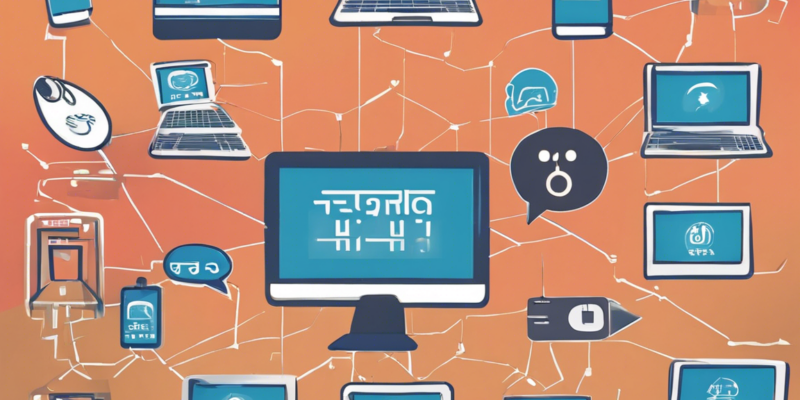The internet has revolutionized the way people communicate, work, shop, and access information. It has become an integral part of modern life, but many users may not fully understand how it works. In this comprehensive guide, we will explore the basics of the internet, including its history, infrastructure, key concepts, and common uses.
History of the Internet
The precursor to the modern internet can be traced back to the 1960s when the United States Department of Defense developed ARPANET, a pioneering network that connected research institutions. Over time, ARPANET evolved into the internet we know today, with the development of protocols such as TCP/IP (Transmission Control Protocol/Internet Protocol) that enabled different networks to communicate with each other.
How the Internet Works
At its core, the internet is a global network of interconnected devices, including computers, servers, routers, and switches. Data is transferred between these devices in the form of packets, which are small units of information. When you access a website or send an email, your device breaks down the data into packets, which are then routed through the network to their destination.
Key Concepts
-
IP Address: An IP address is a unique numerical label assigned to each device connected to a network. There are two types of IP addresses: IPv4, which uses a 32-bit address scheme, and IPv6, which uses a 128-bit address scheme to accommodate the growing number of internet-connected devices.
-
Domain Name System (DNS): The DNS is like the internet’s phone book. It translates domain names (e.g., google.com) into IP addresses, allowing users to access websites using easy-to-remember names instead of complex numerical addresses.
-
Web Browser: A web browser is a software application that allows users to access and navigate the World Wide Web. Popular web browsers include Google Chrome, Mozilla Firefox, and Safari.
-
Internet Service Provider (ISP): An ISP is a company that provides users with access to the internet. ISPs connect customers to their network, allowing them to browse the web, send emails, and stream content.
-
Wi-Fi: Wi-Fi is a wireless networking technology that allows devices to connect to the internet without the need for physical cables. Wi-Fi networks are commonly found in homes, offices, and public spaces.
Common Uses of the Internet
The internet serves a wide range of purposes in today’s society. Some common uses include:
-
Communication: Email, instant messaging, social media, and video conferencing platforms allow people to stay connected with friends, family, and colleagues.
-
Information Access: Search engines like Google and online encyclopedias like Wikipedia provide instant access to vast amounts of information on nearly any topic.
-
Online Shopping: E-commerce websites such as Amazon and eBay enable users to browse and purchase a wide variety of products from the comfort of their homes.
-
Entertainment: Streaming services like Netflix and YouTube offer a wealth of movies, TV shows, music, and other forms of digital entertainment.
-
Education: Online courses, virtual classrooms, and educational resources allow people to learn new skills and expand their knowledge remotely.
Frequently Asked Questions (FAQs)
- What is the difference between the internet and the World Wide Web?
-
The internet is a global network of interconnected devices, while the World Wide Web is a system for accessing information over the internet through websites and web pages.
-
Is the internet the same as Wi-Fi?
-
No, Wi-Fi is a wireless networking technology that allows devices to connect to the internet without physical cables. The internet refers to the global network of interconnected devices.
-
How do web browsers work?
-
Web browsers retrieve and display web pages by sending requests to web servers, which respond with the necessary data to render the page on the user’s screen.
-
What is a modem and how does it work?
-
A modem is a device that modulates and demodulates digital data for transmission over analog communication lines. It converts digital signals from a computer into analog signals for transmission over telephone or cable lines.
-
What are cookies and why are they used on websites?
-
Cookies are small text files stored on a user’s device by websites they visit. They are used to remember user preferences, login sessions, and other information to enhance the user experience.
-
How secure is online shopping?
-
Online shopping can be secure if conducted on encrypted websites (https://) and using secure payment methods like credit cards or PayPal. It’s important to safeguard personal and financial information when making online purchases.
-
What is the role of an ISP in internet connectivity?
-
An ISP provides users with access to the internet by connecting them to the ISP’s network infrastructure. ISPs offer various types of connections, such as DSL, cable, fiber optic, and wireless.
-
Can the internet be accessed without an ISP?
-
In most cases, users need an ISP to access the internet. However, alternative methods like public Wi-Fi networks, mobile data plans, and satellite internet services can provide internet connectivity without a traditional ISP.
-
What is the difference between upload and download speeds?
-
Upload speed refers to the rate at which data is sent from a user’s device to the internet, while download speed is the rate at which data is received from the internet to the user’s device. Upload speeds are important for activities like video calls and cloud storage, while download speeds impact activities like streaming and downloading files.
-
How has the internet evolved over time?
- The internet has evolved from a text-based network to a multimedia-rich environment with advancements like high-speed broadband connections, mobile internet access, cloud computing, and the Internet of Things (IoT). Trends like social media, online streaming, and e-commerce have transformed the way people interact, consume content, and conduct business online.
In conclusion, the internet is a vast and complex network that plays a central role in modern society. Understanding its basics, including its history, infrastructure, key concepts, and common uses, can empower users to make the most of this incredible technological resource. By knowing how the internet works and how to navigate its various features, individuals can harness its potential for communication, information access, entertainment, and much more.










